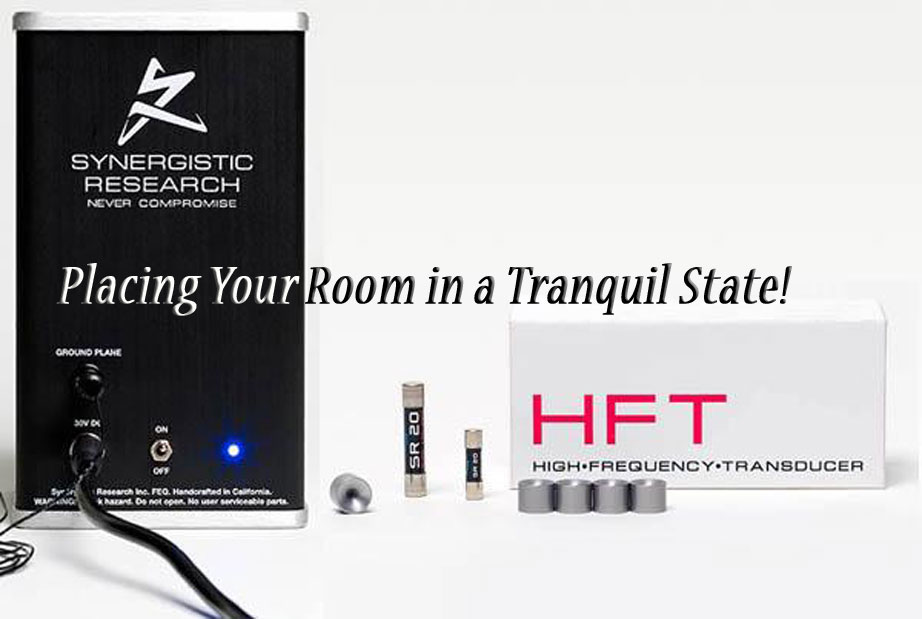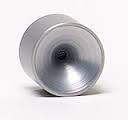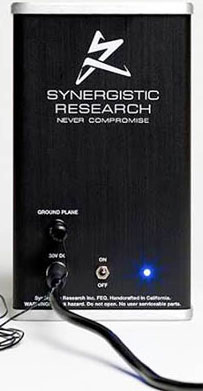Synergistic Research FEQ and HFT

 The largest component in one’s system is the listening room! It is the one component that is perhaps the most commonly overlooked and misunderstood. In my experience, you could spend ungodly amounts on loudspeakers, amplifiers, front-end components, and cables BUT without treating the room properly by addressing the room distortions it brings,you will never really hear what your system is capable of OR the true essence of music you so enjoy. I must admit there are a multitude of room acoustic products in the market place and I’ve had an assortment of them in my system along the way. Fortunately for me, my affilation with friend and ST publisher Clement Perry, who always seems to be right on the bleeding edge of the latest acoustic enhancement devices has opened my eyes and ears to some incredible discoveries. Products like acoustic room enhancers like the Stein Harmonizers, HighEnd Novum PMR, and the IPC EQ Panels/Energizers have greatly enhanced my enjoyment of music and this hobby. But this time however, I’m going beat CP to the punch and be the first to report on a revolutionary room acoustic enhancement device from Synergistic Research which has already won numerous awards and could make many competing products rush back to their respective drawing boards.
The largest component in one’s system is the listening room! It is the one component that is perhaps the most commonly overlooked and misunderstood. In my experience, you could spend ungodly amounts on loudspeakers, amplifiers, front-end components, and cables BUT without treating the room properly by addressing the room distortions it brings,you will never really hear what your system is capable of OR the true essence of music you so enjoy. I must admit there are a multitude of room acoustic products in the market place and I’ve had an assortment of them in my system along the way. Fortunately for me, my affilation with friend and ST publisher Clement Perry, who always seems to be right on the bleeding edge of the latest acoustic enhancement devices has opened my eyes and ears to some incredible discoveries. Products like acoustic room enhancers like the Stein Harmonizers, HighEnd Novum PMR, and the IPC EQ Panels/Energizers have greatly enhanced my enjoyment of music and this hobby. But this time however, I’m going beat CP to the punch and be the first to report on a revolutionary room acoustic enhancement device from Synergistic Research which has already won numerous awards and could make many competing products rush back to their respective drawing boards.
Synergistic Research has been on a roll as of late introducing new products, revamping existing products, and reinventing existing state of the art products with all being based on the concept known as Uniform Energy Field Technology (UEFT). Applications of the UEFT have included energy field power conditioning, internal component/circuit energy field power conditioning, in room sound wave energy conditioning, and amplified signal conditioning. According to Peter Hansen, SR’s VP, application of this technology is expanding beyond high end audio and SR is just getting started. My review will cover SR’s latest acoustic treatment products which were introduced at the 2013 RMAF, the Frequency Equalizer (FEQ) and the High Frequency Transducer (HFT).
HFT
 Each HFT is 8mm in diameter (.312”) and 8mm tall, passive in nature, made from some type of metallic alloy, and are sold in packs of five. SR recommends the use of BluTak to attach an HFT to a treated surface but other methods such as double stick tape work as well. According to the SR website, “HFTs are tiny high frequency transducers that clean up high frequency harmonics in your listening room and cancel harmonic noise on any surface they are placed by replacing random out-of-tune resonance with sympathetic resonance that complements the music”. The SR website details the installation of the HFTs and their respective levels of implementation. Level 1 through 3 treats the room front, side and ceiling surfaces while Level 4 places one HFT on each side of your speakers (four per speaker is needed). The other applications of HFTs include placement on digital cables, internal components, etc.
Each HFT is 8mm in diameter (.312”) and 8mm tall, passive in nature, made from some type of metallic alloy, and are sold in packs of five. SR recommends the use of BluTak to attach an HFT to a treated surface but other methods such as double stick tape work as well. According to the SR website, “HFTs are tiny high frequency transducers that clean up high frequency harmonics in your listening room and cancel harmonic noise on any surface they are placed by replacing random out-of-tune resonance with sympathetic resonance that complements the music”. The SR website details the installation of the HFTs and their respective levels of implementation. Level 1 through 3 treats the room front, side and ceiling surfaces while Level 4 places one HFT on each side of your speakers (four per speaker is needed). The other applications of HFTs include placement on digital cables, internal components, etc.
FEQ
 The FEQ is an active device, having the dimensions of 7 ¼” tall x 4 1/8” wide and deep, is powered by a wall wart, grounded by a three phase IEC, and is black in color. A very bright blue light indicates when the FEQ is energized. According to the SR website, “the FEQ is an ultra low frequency RF pulse generator that acts as a low frequency dither to overpower the ambient RFI and EMI fields thus acting like a Tranquility Base for your listening room”. The FEQ is typically placed somewhere near the back wall centered between the main speakers in one’s room. Acting like an amplifier for the HFT, the FEQ is said to excite the HFTs by its ultra-low frequency pulse.
The FEQ is an active device, having the dimensions of 7 ¼” tall x 4 1/8” wide and deep, is powered by a wall wart, grounded by a three phase IEC, and is black in color. A very bright blue light indicates when the FEQ is energized. According to the SR website, “the FEQ is an ultra low frequency RF pulse generator that acts as a low frequency dither to overpower the ambient RFI and EMI fields thus acting like a Tranquility Base for your listening room”. The FEQ is typically placed somewhere near the back wall centered between the main speakers in one’s room. Acting like an amplifier for the HFT, the FEQ is said to excite the HFTs by its ultra-low frequency pulse.
Welcome to the IMAX Theatre
My reviewing system includes the LauferTeknik Memory Player 64 Full Version Player, Pioneer bdp-09fd blu ray player, Ayon Audio Triton MKII integrated amplifier fitted with Ayon BT SX KT88 power tubes and Mazda Cifte signal tubes, Acoustic Zen Crescendo loudspeakers, REL R-528 subwoofer, Klee Acoustics speaker cables and interconnects, Synergistic Research Tesla LE REL SPEC Subwoofer Reference cable, Synergistic Research Element AC power cords, Synergistic Research PowerCell 10 SE MKII conditioner, Synergistic Research Tranquility Base under the LT MP64, Synergistic Research Tesla Plex SE outlets, IPC Acoustic Energizers, Stein H2 Harmonizers and Magic Stones, ShatkiHallograph, Stillpoints Ultra 5s footers and LessLoss Blackbodies behind the AZ Crescendo loudspeaker crossovers. As for my listening area, its 14.5’ wide, has a 9’ ceiling, and has an open back wall to 1500 sq ft of first floor living area.
It can be said that my listening room is the poster child for bad room acoustics and I’m sure many audionuts like me are in a similar situation. I have a fixed glass fireplace and wooden cabinets at the first reflection flanked by two full size windows on either side on the right side of my room, my quasi nearfield reviewing system is not centered in the room due to the positioning of a couch and loveseat, my back wall is asymmetrically closed by four feet on the right side (fireplace and windows side), one third of my room is covered with hardwood flooringwith the balance being carpeted, my ceiling has a textured finish with a ceiling fan centrally located, and the left side of the room starts with a recessed set of cabinets and desk located toward the front wall with a framed painting at the first reflection. Without room treatments, the sound field is poorly focused, lacks depth, is localized at each loud speaker, full of distortions, suffers from signal compression, and is lifeless.
I will try to access the performance of the SR FEQ and HFT in a series of steps: (1) baseline my system sans all room acoustic treatments, (2) install the FEQ and establish what it brings to the table by itself, (3) individually install the four levels of HFTs, (4) evaluate the synergy of the FEQ and HFTs, and (5) reinstall my reference room enhancement devices (two Shatki Holographs behind my AZ Crescendos, one acoustic panel covering the fireplace glass, and a mix of Stein Harmonizers, Stones, and Diamonds) and compare this harmonious combination to the SR FEQ/HFT system.
Let’s cut right to the chase; the combination of the FEQ and HFT has made the biggest improvement in my system’s performance since I’ve been reviewing high-end audio components over the last 11 years. I’m sure there’s an additive effect going here with between the Powercell MKIII, Tranquility base and the HFT/FEQ since they seem to transform one’s system in similar ways and the same design philosophy was used. Considering the physical size of the HFTs and FEQ as compared to all other room acoustic enhancement devices and their comparative performance, the FEQ and HFT resides in the best in class category for room acoustic treatment. From an ergonomic and aesthetic standpoint alone they are revolutionary in the application of room acoustic enhancement. Happy was the day I removed my previous reference room acoustic treatments and replaced them with the FEQ and HFTs (and it wasn’t a secret that my family felt the same way).
 When my son recently came home from college for the weekend and I started to explain why our listening room looked so different, he said he could tell based on my enthusiasm, something transformative had occurred in my reviewing system. Like the SR Powercell and Tranquility Base it was easy to determine what areas of sonic bliss ensued when the four levels of HFTs were install and it flicked the switch on the FEQ. While listening to track 4, “River” from Herbie Hancock, River: The Joni Letters [Verve Records] as an HDtracks 24-bit /96k Hz download, I noted the following:
When my son recently came home from college for the weekend and I started to explain why our listening room looked so different, he said he could tell based on my enthusiasm, something transformative had occurred in my reviewing system. Like the SR Powercell and Tranquility Base it was easy to determine what areas of sonic bliss ensued when the four levels of HFTs were install and it flicked the switch on the FEQ. While listening to track 4, “River” from Herbie Hancock, River: The Joni Letters [Verve Records] as an HDtracks 24-bit /96k Hz download, I noted the following:
a. The edge and smear on vocals and instruments was reduced significantly
b. The acoustic noise floor dropped to indiscernible levels allowing for the finest details to be revealed.
c. The room boundaries seemed to disappear while portraying a surround sound (you are there) effect
d. Individual notes had a more natural decay with a greater sense of space
e. The lowest octaves were defined with greater authority and speed
f. The soundscape was more layered and holographic.
g. The overall volume increased with better left to right separation (I believe due to a reduction in signal compression).
h. The listening position sweet spot was increased from to narrow fixed space to most of the width along my 90” wide couch.
Equally transformative was the effect heard during the viewing of the Blu-ray disc, Closed Circuit. The sounds of the grand piano which faded in out during the film, had greater presence and projected directly in front of me. With each note played, I came to realize how complex the harmonic structure can sound when played on a grand piano. My wife, who has played the piano for over 30 years was amazed at how close my system now sounded like a real piano. I also noticed the enhanced sense of space and heard for the first time the actual room acoustics on the sets in the movies such as inEnder’s Game (in the training arena) and Escape Plan (open detainment area). This perspective provided by FEQ and HFT greatly added to the enjoyment of these movies.
By themselves, the FEQ and the first level of installed HFTs compared to my reference room treatments, outperformed my reference in areas of soundstage width and depth, layering of instruments, image bloom, lowering of the acoustic noise floor (resulting in less grain and grit), and extreme frequency extension. Adding additional level of HFTs, magnified these improvements to the point where regression back to a lower level was unthinkable. The FEQ and the four levels of HFTs used together far exceeded the performance of my reference room treatments in all ways discussed above but would stood out for me was how the soundstage was immersed within the entire room boundary creating a surround sound effect that no other room treatment has provided in addition to the long decay of individual notes. Confirmation of how transformative the FEQ and HFTs werewas further demonstrated by while changing and comparing the mode of operation in my Ayon Audio Triton integrated tube amplifier. My AA Triton has two modes of operation, triode and pentode. The lower output, triode mode, which is my preference for music, has a more intimate, ethereal, and, holographic sound with a soundstage confined between the two main speakers whereas the more powerful pentode mode is a much bigger and bolder sound with explosive dynamics. With my room treated by the SR duo,the triode mode on my AA Triton sounded as big and dynamic as the pentode mode was when my previous reference treatments were employed.
At the suggestion of Peter Hansen, VP of SR, I opened up the LT Memory Player 64 and placed three HFTs on critical internal components within the chassis. Two HFTs were placed on the Lynx DAC output stage chips and one HFT was placed on a gang of seven capacitors in parallel (DAC bypass capacitors). Using selected cuts from Hiroshima: The Bridge[Heads Up International], a 24-bit/96k Hz HDtracks download, I evaluated what HFTs brought to the table in this application. With the HFTs installed, the LT MP64 sounded a smidge less digital (hard to believe since this digital source is known for being as analog as it gets), was more holographic, and had greater bass output. After this demo, I wished I had more HFTs to play with.
Summary and Conclusions
It’s my belief that if you are putting together an audio system and skip treating the room, you’ll never hear how good your system really is. The FEQ and HFTs has brought me closer to the music more than any product I have ever reviewed. Compared to my previous reference at nearly half the price and considering its size and how it’s applied within our family room (happy wife … happy life), the combination of FEQ and HFTsis my new reference. The FEQ and HFT is a paradigm shift in room treatment device design and delivers on its promised performance. Highly recommended.


Specifications:
HFT – High Frequency Transducer Technology, $299/5-pack or $75/ea.
FEQ – Frequency Equalizer Technology, $995
Address:
Synergistic Research, Inc.
17401 Armstrong Avenue
Suite 102
Irvine, CA 92614
Website: www.synergisticresearch.com
Phone numbers: (800) 578-6489 within US and (949) 476-0000 outside the US
Stereo Times Masthead
Publisher/Founder
Clement Perry
Editor
Dave Thomas
Senior Editors
Frank Alles, Mike Girardi, Russell Lichter, Terry London, Moreno Mitchell, Paul Szabady, Bill Wells, Mike Wright, and Stephen Yan,
Current Contributors
David Abramson, Tim Barrall, Dave Allison, Ron Cook, Lewis Dardick, John Hoffman, Dan Secula, Don Shaulis, Greg Simmons, Eric Teh, Greg Voth, Richard Willie, Ed Van Winkle, Rob Dockery, Richard Doran, and Daveed Turek
Site Management Clement Perry
Ad Designer: Martin Perry





Be the first to comment on: Synergistic Research FEQ and HFT